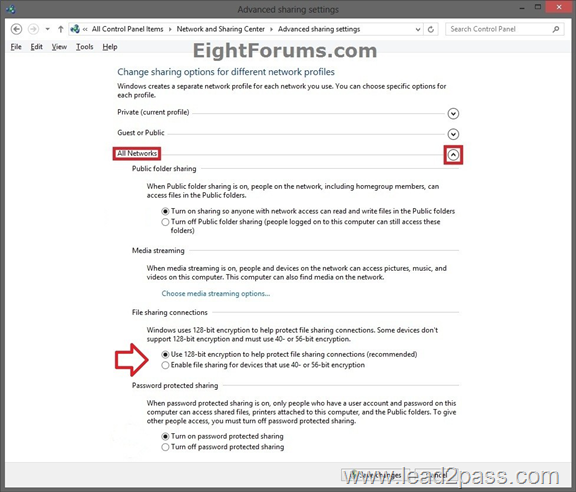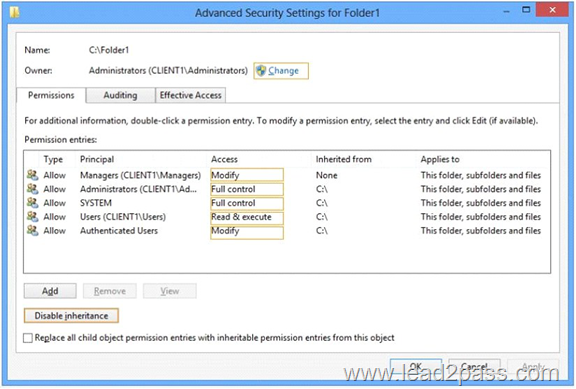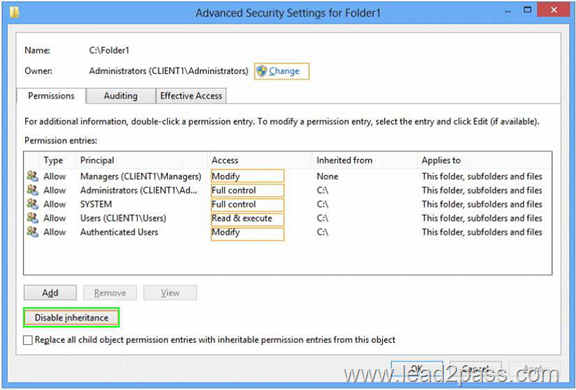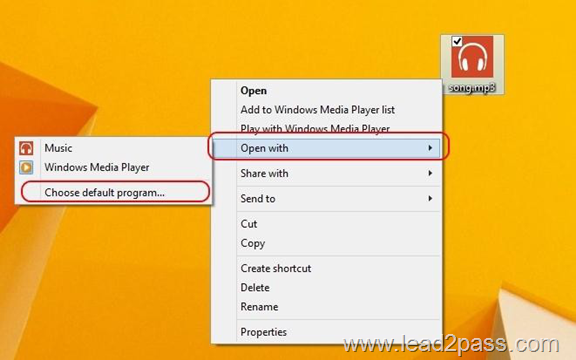OFFER Free Microsoft 70-687 PDF and VCE Exam Dumps 211-220
Vendor: Microsoft
Exam Code: 70-687
Exam Name: Configuring Windows 8.1
Version: 14.91
QUESTION 211
You administer a Windows 8.1 Pro computer. The computer has File History turned on, and system protection turned on for drive C.
You accidentally delete a folder named Libraries\Customers by using the Shift+Delete keyboard shortcut.
You need to restore the most recent version of the folder to its original location.
Which approach should you use to restore the folder?
A. Recycle Bin
B. The latest restore point
C. File History
D. A manually selected restore point
Answer: B
Explanation:
http://blogs.msdn.com/b/b8/archive/2012/07/10/protecting-user-files-with-file- history.aspx
Protecting user files with File History
File History is a backup application that continuously protects your personal files stored in Libraries, Desktop, Favorites, and Contacts folders. It periodically (by default every hour) scans the file system for changes and copies changed files to another location. Every time any of your personal files has changed, its copy will be stored on a dedicated, external storage device selected by you. Over time, File History builds a complete history of changes made to any personal file.
It’s a feature introduced in Windows 8 that offers a new way to protect files for consumers. It supersedes the existing Windows Backup and Restore features of Windows 7.
Before you start using File History to back up your files, you’ll need to set up a drive to save files to. We recommend that you use an external drive or network location to help protect your files against a crash or other PC problem.
File History only saves copies of files that are in your libraries, contacts, favorites, and on your desktop. If you have folders elsewhere that you want backed up, you can add them to one of your existing libraries or create a new library.
Advanced settings can be accessed from the File History control panel applet.
File History also supports new storage features introduced in Windows 8. Users who have lots of data to back up can use Storage Spaces to create a resilient storage pool using off- the-shelf USB drives. When the pool fills up, they can easily add more drives and extra storage capacity to the pool.
QUESTION 212
You use a computer that has Windows 7 Professional (32-bit) installed.
You need to migrate the computer to Windows 8.1 Pro (64-bit).
Which installation method should you use?
A. Download and run Windows 7 Upgrade Advisor.
B. Download and run Windows 8.1 Upgrade Assistant.
C. Start Windows 8.1 custom installation from a DVD.
D. Open Windows Anytime Upgrade.
Answer: C
Explanation:
http://windows.microsoft.com/en-us/windows-8/upgrade-to-windows-8
Update to Windows 8.1: FAQ
Can I update from a 32-bit version of Windows to a 64-bit version of Windows 8.1?
If your PC has a 64-bit capable processor (CPU) but is currently running a 32-bit version of
Windows, you can install a 64-bit version of Windows 8.1, but you’ll need to buy it as a DVD and perform a clean installation. You won’t be able to keep any files, settings, or apps when you update from a 32-bit to a 64-bit version.
QUESTION 213
A company has Windows 8.1 client computers.
All user data is stored locally. Each data file has a system access control list (SACL).
You need to ensure that an event is generated when a user modifies a local file.
Which audit policy setting should you configure?
A. Audit process tracking
B. Audit policy change
C. Audit object access
D. Audit privilege use
Answer: C
Explanation:
http://technet.microsoft.com/en-us/library/cc776774%28v=ws.10%29.aspx
Audit object access
This security setting determines whether to audit the event of a user accessing an object– for example, a file, folder, registry key, printer, and so forth–that has its own system access control list (SACL) specified.
If you define this policy setting, you can specify whether to audit successes, audit failures, or not audit the event type at all. Success audits generate an audit entry when a user successfully accesses an object that has an appropriate SACL specified. Failure audits generate an audit entry when a user unsuccessfully attempts to access an object that has a SACL specified.
QUESTION 214
A company has Windows 8.1 client computers. A client computer named COMPUTER1 has a shared folder named Computer1 located in the user’s Downloads folder.
Computer1 is shared only with employees in the Marketing department.
All Marketing employees can connect to Computer1 from their client computers.
A Marketing employee is unable to connect to Computer1 from a legacy device that is not compatible with the Windows 8.1 default sharing settings.
The device is able to connect to resources on other client computers.
You need to configure COMPUTER1 to allow the device to connect to Computer1.
Which setting should you enable?
A. Turn off network discovery
B. Use 128-bit encryption to help protect file sharing connections
C. Turn on sharing so anyone with network access can read and write files in the Public folders
D. Enable file sharing for devices that use 40- or 56-bit encryption
E. Turn off password protected sharing
Answer: D
Explanation:
http://www.eightforums.com/tutorials/9925-file-sharing-connections-encryption-change-settings-windows-8-a.html
How to Change File Sharing Connections Encryption Settings in Windows 8 and 8.1
Windows 8 uses 128-bit encryption to help protect file sharing connections.
Some devices don’t support 128-bit encryption and must use 40- or 56-bit encryption.
QUESTION 215
Hotspot Question
You administer Windows 8.1 Pro computers in your company network, including a computer named Client1.
On Client1, you create a new folder named C:\Folder1 and configure its NTFS permissions.
You need to ensure that only members of a group named Managers can access the folder content.
In the Advanced Security Settings for Folder1 pane, which security setting should you configure? (To answer, select the appropriate setting in the answer area.)
Answer:
QUESTION 216
You administer Windows 8.1 computers in your company network.
Music files with the MP3 extension are opening in the Music Windows Store app.
You need to ensure that MP3 files always open in the Windows Media Player desktop application.
What should you do?
A. From Control Panel, open Default Programs, open Set your default programs, and then in associations
for Music, clear the .mp3 selection.
B. From Windows Media Player, select Options, and then on the Player tab, select the Add local media
files to library when played option.
C. Right-click an MP3 file, select Open With, choose default program, and then select Windows Media
Player with the use this app for all .MP3 files option selected.
D. From Control Panel, open Default Programs, open Change AutoPlay setting, and then select the Play
(Windows Media Player) setting for Music.
Answer: C
Explanation:
The default program for mp3 files is the Music metro app.
You can even notice the icon for the mp3 file:
But you can change the default file association:
And notice at once the different file icon:
QUESTION 217
A Windows 8.1 computer hosts multiple virtual machines.
The computer contains one hard drive with two partitions.
You need to configure a new virtual machine to use the second physical partition of the host computer as the primary boot device.
What kind of virtual hard disk should you use?
A. Pass-through
B. Fixed-size
C. Differencing
D. Dynamic
Answer: A
Explanation:
http://windowsitpro.com/virtualization/hyper-v-disk-configuration-options
Hyper-V Disk Configuration Options
VHDs: Fixed, Dynamic, Differencing
By default, new VMs are created with an attached VHD. These disks represent Microsoft’s open format for virtual disks, and they have some very useful benefits.
Another important consideration with Hyper-V disks is managing storage capacity. Hyper-V has three options for creating new VHDs: fixed size, dynamically expanding, and differencing. As you can probably guess, fixed-size VHDs provision the entire disk size as the disk is created. Dynamically expanding disks consume only as much space as is actually used by data on the disk.
Differencing VHDs let you link multiple VHDs to one another.
Pass-Through Disks
Yet another type of disk, called a pass-through disk, isn’t a VHD at all. These disks are created by attaching a disk volume to a Hyper-V host, typically through either an iSCSI or Fibre Channel connection. After the disk volume is attached to the Hyper-V host, the disk is then passed through to an awaiting VM–hence the name.
Further Information:
http://blogs.technet.com/b/askcore/archive/2008/10/24/configuring-pass-through-disks-in-hyper-v.aspx
Configuring Pass-through Disks in Hyper-V
QUESTION 218
You attach an external drive to a Windows 8.1 computer.
You need to ensure that scheduled defragmentation does not run on the external drive.
What should you do?
A. Disable write caching on the external drive.
B. Run the defrag command and configure the schedule settings.
C. Run the diskpart command and select the external drive.
D. Configure the Optimize Drives setting to exclude the external drive.
Answer: D
http://www.eightforums.com/tutorials/8616-optimize-drives-schedule-change-windows-8-a.html How to Change "Optimize Drives" Schedule Settings in Windows 8 and 8.1
Optimize Drives, previously called Disk Defragmenter, helps to optimize the different types of drives that PCs use today. No matter which type of drive your PC uses, Windows automatically chooses the optimization that’s right for your drive. By default, Optimize Drives runs automatically on a weekly schedule during the time you have set for automatic maintenance. But you can also optimize drives on your PC manually.
QUESTION 219
You administer Windows RT tablets in your company network. All users in the company have Microsoft Exchange Server 2010 mailboxes and access them by using Outlook Web Access or Outlook 2010. All tablets are registered on the Microsoft Exchange server as mobile devices.
A user informs you that he has lost his tablet.
The user is able to connect to the company network from his home computer.
You need to delete Microsoft Exchange information from the lost tablet.
Which application should you use?
A. Outlook 2010
B. Outlook Web Access
C. Active Directory Users and Computers
D. Routing and Remote Access Server
Answer: B
Explanation:
http://office.microsoft.com/en-us/outlook-help/delete-all-information-from-your-lost-phone- or-tablet-HA102834573.aspx
Delete all information from your lost phone or tablet
If you use your phone or tablet to access your mailbox, your phone or tablet likely stores a lot of sensitive information, such as personal identification or confidential communications.
If you lose your phone, you should immediately remove all information from the phone.
You can do that from your mailbox by using a process called remote device wipe.
Important
You can only clear the data from a device if it was set up to use Exchange ActiveSync. If you’re not sure whether your phone was set up to use Exchange ActiveSync, you can simply try the procedure below and find out. For more information, see "What else do I need to know?" later in this topic.
Remove all data from your phone or tablet
Sign in to your account using Outlook Web App. For help signing in to your account, see Sign in to Outlook Web App.
In Outlook Web App, on the toolbar, click Settings GearIcon > Options < phone < mobile devices.
Select the phone or tablet that you want to wipe.
Click Wipe Device.
Click OK.
Click Remove Phone from List.
Further Information:
http://oxfordsbsguy.com/2014/05/19/how-to-remote-wipe-a-mobile-phone-using-outlook- web-access/
QUESTION 220
Two Windows 8.1 computers named COMPUTER1 and COMPUTER2.
You connect from COMPUTER1 to COMPUTER2 by using Remote Desktop.
You are unable to copy any files between COMPUTER1 and COMPUTER2 during the Remote Desktop session.
You need to ensure that you can copy files between the computers during the Remote Desktop session.
What should you do?
A. On COMPUTER1, open Remote Desktop Connection and configure the Local devices and resources settings.
B. On COMPUTER2, add COMPUTER1 to the trusted hosts in Windows Remote Management (WinRM).
C. On COMPUTER2, open Remote Desktop Connection and configure the Local devices and resources settings.
D. On COMPUTER1, add COMPUTER2 to the trusted hosts in Windows Remote Management (WinRM).
Answer: A
Explanation:
http://technet.microsoft.com/en-us/library/cc770631.aspx
Make Local Devices and Resources Available in a Remote Session
Remote Desktop Services provides users the ability to access their local devices and resources in remote sessions. Users can access resources such as local drives, printers, the Clipboard, and supported Plug and Play devices. This is usually referred to as redirection.
http://windows.microsoft.com/en-us/windows7/how-can-i-use-my-devices-and-resources-in-a-remote-desktop-session
How can I use my devices and resources in a Remote Desktop session?
Redirecting a device on your computer makes it available for use in a Remote Desktop session. If you have a recent version of Remote Desktop, you can redirect most devices, including printers, smart cards, serial ports, drives, Plug and Play devices, media players based on the Media Transfer Protocol (MTP), and digital cameras based on the Picture Transfer Protocol (PTP). Some USB devices can be redirected, and you can also redirect your Clipboard.
If you want to pass Microsoft 70-687 exam successfully, donot missing to read latest lead2pass Microsoft 70-687 dumps.
If you can master all lead2pass questions you will able to pass 100% guaranteed.
http://www.lead2pass.com/70-687.html
Why Choose Lead2pass?
If you want to pass the exam successfully in first attempt you have to choose the best IT study material provider, in my opinion, Lead2pass is one of the best way to prepare for the exam.
 |
 |
 |
 |
 |
|
|---|---|---|---|---|---|
 |
 |
 |
 |
 |
|
| Lead2pass | Testking | Pass4sure | Actualtests | Others | |
| $99.99 | $124.99 | $125.99 | $189 | $29.99-$49.99 | |
| Up-to-Dated | ✔ | ✖ | ✖ | ✖ | ✖ |
| Real Questions | ✔ | ✖ | ✖ | ✖ | ✖ |
| Error Correction | ✔ | ✖ | ✖ | ✖ | ✖ |
| Printable PDF | ✔ | ✖ | ✖ | ✖ | ✖ |
| Premium VCE | ✔ | ✖ | ✖ | ✖ | ✖ |
| VCE Simulator | ✔ | ✖ | ✖ | ✖ | ✖ |
| One Time Purchase | ✔ | ✖ | ✖ | ✖ | ✖ |
| Instant Download | ✔ | ✖ | ✖ | ✖ | ✖ |
| Unlimited Install | ✔ | ✖ | ✖ | ✖ | ✖ |
| 100% Pass Guarantee | ✔ | ✖ | ✖ | ✖ | ✖ |
| 100% Money Back | ✔ | ✖ | ✖ | ✖ | ✖ |







